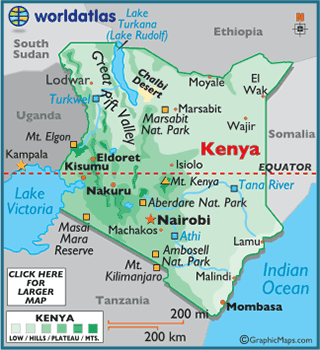One aspect of Nairobi has proven particularly hard to reconcile, and that's the juxtaposition of wealth and poverty throughout the city. Junction is an American-style mall about a 45 minute walk from our apartment; complete with a fro-yo place, Century theaters, and Levis, it's strikingly reminiscent of shopping back home. Not 10 minutes from Junction though is Kibera, one of Nairobi's largest slums. Until this past weekend, I'm embarrassed to say, I'd been to Junction at least six times and to Kibera not once. That changed when a friend of Rebecca's offered to introduce us to the Human Needs Project on Sunday morning.
We met Rebecca's friend, an employee of the Human Needs Project, at a nearby coffee house, and she drove us into the slum, passing shops, churches, and stalls through rutted streets streaming with people to Kibera's main center. There, we found ourselves at the doorstep of the Human Needs Project, a community and town center. The vision of Danish actress Connie Nielsen, the HNP opened a mere three months ago and is already an impressive addition to Kibera. In just one building, it provides laundry facilities (both machine and hand-washing), male and female bathrooms complete with showers, classrooms, an internet cafe, a food-and-coffee cafe, and fresh water station where community members can fill up jerrycans with clean, safe water. The building sits on top of the borehole that started it all; when Connie completed filming a movie in Kibera, she asked the community if they wanted for anything and the reply was access to water. The HNP houses an impressive water filtration system that draws its source from an aquifer 300 meters deep and its inspiration from the rock-and-sand, gravity-driven filtration systems developed by the Romans. Now I'm no water engineer (in fact, I'm not any kind of engineer and last looked at a calculus textbook in high school) but I was in awe of how the HNP manages and maximizes the resources at its disposal. Everything about the building was innovative, from the plants that act as natural insect repellents to the gray-water that's recycled to the solar panels being installed on the roof. What's more, the founder insists that this be a place that is first and foremost owned by the community; thus community members must pay to use the facilities. It's staffed by residents of Kibera who are trained in skills that they can market to gain employment elsewhere in Nairobi. The HNP is designed to advance and support the potential of Kibera's residents: internet services are meant to be used to manage email, draft a resume or CV, and connect with employers; classes are held to give training in finance management and technical skills; women use laundry facilities to expand clothes-washing businesses. It's even lit up at night to provide security for those in the surrounding area.
Over a cappuccino at the cafe, we discussed the challenges the HNP faces in its early stages. Some in the community voice skepticism about the building; it rises high above the surrounding aluminum-sheeted rooftops and is initially an intimidating presence. Some of the services prove to luxurious for community members. Our guide shared with us that for every 1 woman that uses the shower facilities, 12 men do the same. She explained that at 12 shillings (about 14 cents US), showers are an expensive commodity for women who must make their daily allowances support food, water, and other needs of the family. Men, she finds, are much more likely to use 12 shillings of their day's work for a shower on the way to or from work. Whether or not this reflects something about the gendered dimensions of money management, disposable time, or facility usage, the HNP is constantly brainstorming ways to reach out to the community and create a space that serves the potential and the needs of individuals.
I left looking forward to my next visit to HNP and to seeing how it adapts in its first year. Ideally, if the project is successful it will be scaled up to other, similar areas in Nairobi and around the world. I'll admit, I raised an eyebrow when I first heard that a Hollywood actress had started a project in Kibera. But from everything the community members and staff said Connie makes a genuine and concerted effort to visit as often as possible and can be found sleeves rolled up, baking in the kitchen, cleaning in the bathrooms, and toiling away in the HNP office. A remarkable project with what looks like a bright future, HNP was well worth the visit and a wonderful introduction to Kibera.
It also got me thinking about needs and how much in life I actually require to live. I'm as guilty as anyone of confusing 'need' and 'want': I 'need' a cup of coffee, some chocolate, new work clothes, a change of scene. I have what I truly need in life: my basics covered (food, water, shelter) and I'm blessed to have family and friends I love and that reciprocate. I've had gainful academic and professional opportunities that have been fulfilling and have supported my development. What struck me about the HNP was that it didn't profess a formula for meeting needs that was very different from what I would prescribe for myself. It sees the potential and not the poor in Kibera's communities, which is exactly how I want to be seen by those who support me-- for what I offer and my potential to grow.


.JPG)
.JPG)


.JPG)

.JPG)
.JPG)








.JPG)
.JPG)
.JPG)
.JPG)
.JPG)
.JPG)
.JPG)
_(-mini_map_-rivers).svg.png)
